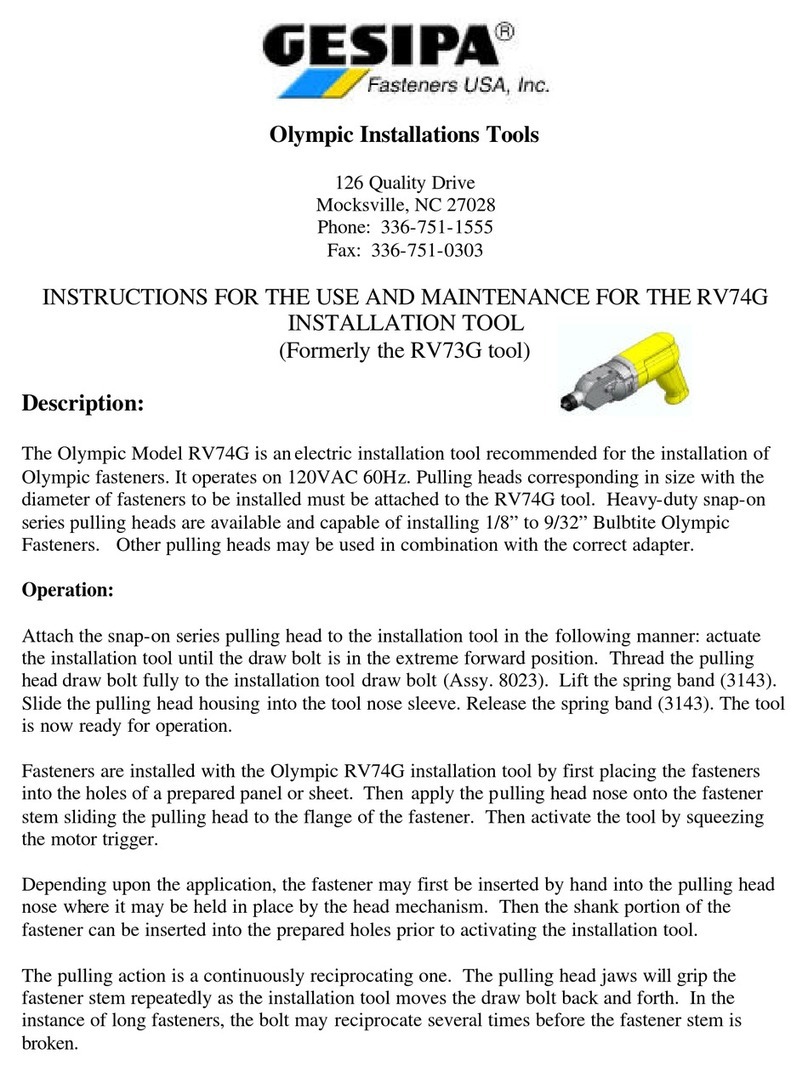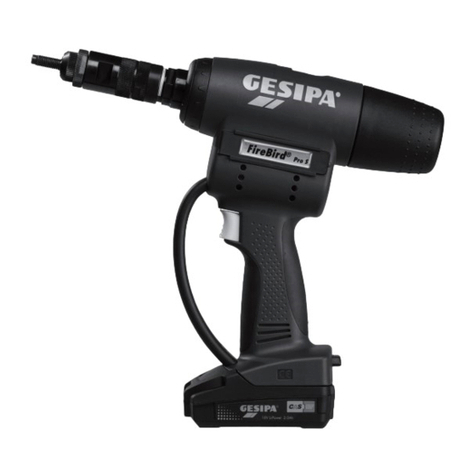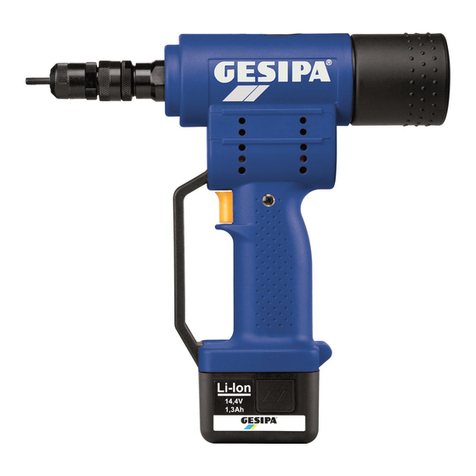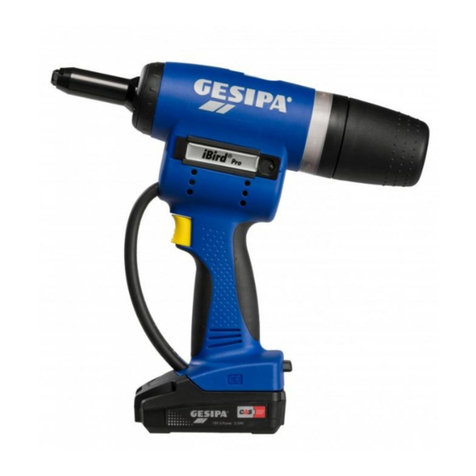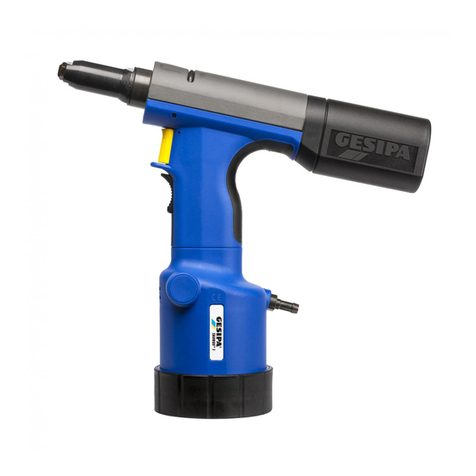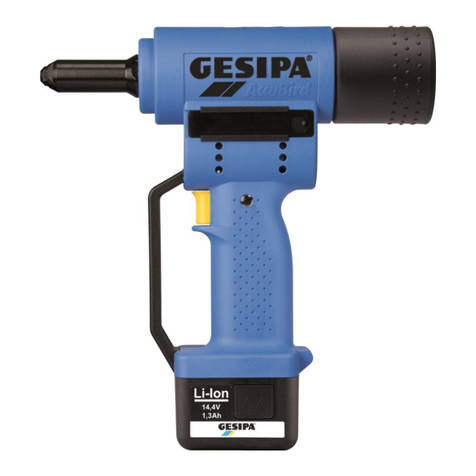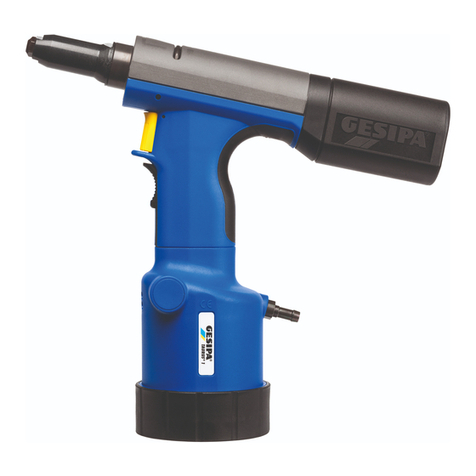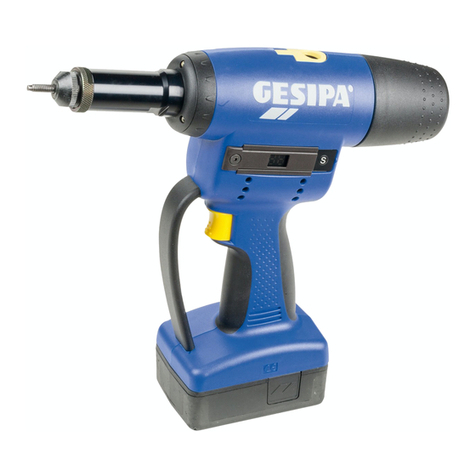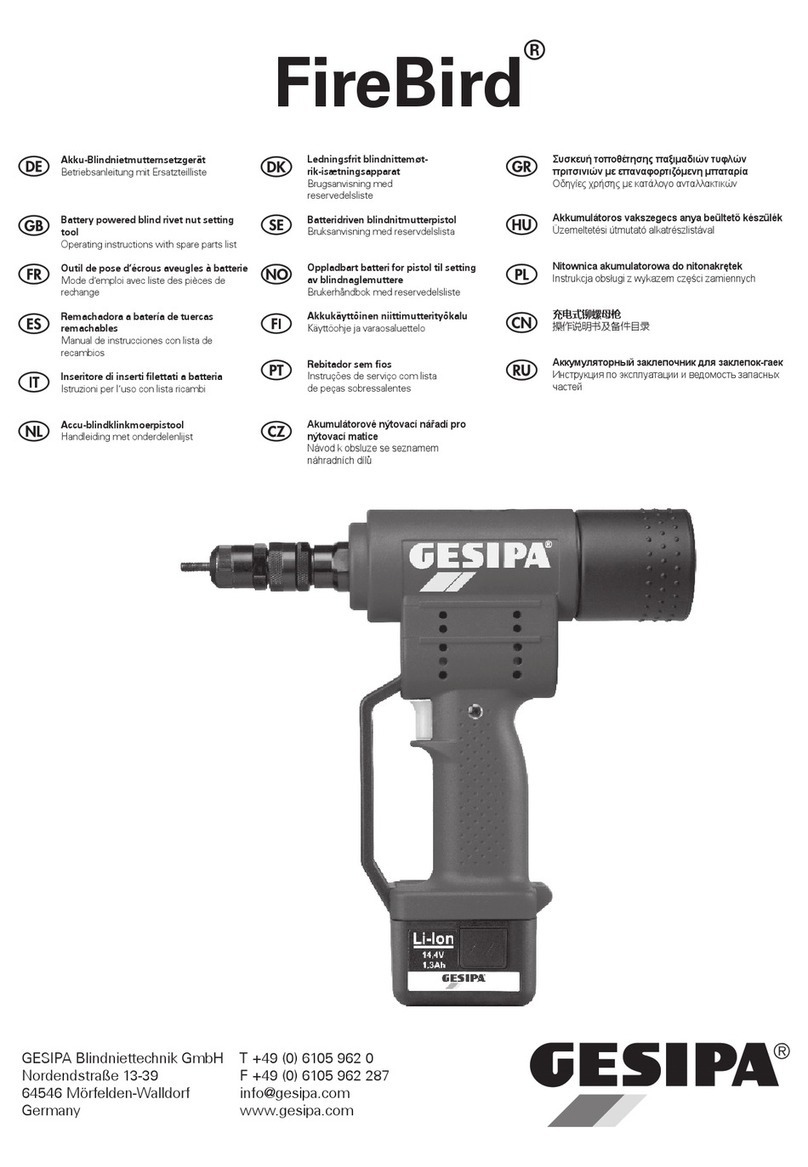7. Inbetriebnahme
Vor Inbetriebnahme Betriebsanleitung sowie
Sicherheitshinweise lesen, beachten
(!)
und
sorgfältig aufbewahren.
Druckluftnetzanschluss zum Nietgerät durch
Fachkraft erstellen.
7.1 Auffangbehälter aufsetzen
Auffangbehälter für Restdorne bis zum An-
schlag (durch Rechtsdrehung) aufschrauben.
7.2
Auswahl und Wechsel des Mundstückes
Achtung!
Immer das der Blindnietgröße
entsprechende Mundstück einsetzen.
(Auswahl nach Tabelle gemäß Punkt 6)
Wechsel des Mundstückes
– Nietgerät vom Druckluftnetz trennen.
– Mundstück von Stahlhülse abschrauben.
– Ausgewähltes Mundstück einschrauben
und festziehen.
7.3 Setzen eines Blindnietes
– Nietgerät an Druckluftnetz anschließen.
– Blindniet in das Mundstück einstecken
und mit dem Nietgerät bis zum Anschlag
in die Fügegut-Bohrung einführen.
– Auslöser betätigen bis der Nietdorn abreißt.
– Auslöser loslassen.
– Der Restdorn wird automatisch in den
Auffangbehälter gefördert (s.Pkt.7.5).
7.4
Ansaugen und Halten eines Blindnietes
Diese Funktion dient dazu, den Blindniet im
Mundstück des Nietgerätes zu halten, wenn
senkrecht nach unten genietet werden soll.
– Absperrventil Nr.88 im Nietgerätekopf mittels
Stift (z.B. Nietdorn) nach links oder rechts bis
zum Anschlag schieben.
– Nach dem Greifen des Nietgerätes den
Schieber Nr.86 bis zum Einrasten nach oben
schieben. Zum Ausschalten der Ansaugung
den Schieber nach unten schieben.
– Durch Zurückschieben des Absperrventils
Nr.88 wird die komplette Ansaugfunktion
des Gerätes abgestellt.
7.5 Entleerung des Auffangbehälters
– Der Auffangbehälter ist rechtzeitig zu ent-
leeren; Überfüllung führt zu Störungen am
Nietgerät.
– Auffangbehälter durch Linksdrehung ab-
schrauben, Restdorne in geeignetem Behälter
sammeln.
– Auffangbehälter aufschrauben.
8. Wartung und Pflege
Der komplette Greifmechanismus muß regel-
mäßig gewartet werden.
8.1 Futterbacken ölen
– Nietgerät vom Druckluftnetz trennen
– Stahlhülse Nr.24 abschrauben
– Kompletten Futtermechanismus bis zum
O-Ring Nr.17 in Ölbad tauchen bzw.
Futterbacken Nr.15 mit Öl benetzen und
abtropfen lassen.
– Zusammenbau in umgekehrter Reihenfolge
8.2 Futterbacken wechseln
– Gerät vom Druckluftnetz trennen
– Stahlhülse Nr.24 abschrauben
– Futtergehäuse Nr.16 abschrauben
– Futterbacken Nr.15 entnehmen
–
Futtergehäuse reinigen und Gleitflächen fetten
– Neue Futterbacken von vorn einsetzen
(werden vom Fett gehalten)
– Zusammenbau erfolgt in umgekehrter
Reihenfolge; alle Teile fest miteinander
verschrauben.
8.3 Hydrauliköl nachfüllen
– Nietgerät vom Druckluftnetz trennen.
– Stahlhülse Nr.24 abschrauben.
– Öl-Nachfüllschraube Nr.30 und Dichtung
Nr.31 mit Torx-Schraubendreher T20
abschrauben.
– Beiliegenden Öl-Nachfüllbehälter mit Deckel
aufschrauben.
– Nietgerät an Druckluftnetz anschließen und
Auslöser betätigen; danach Nietgerät vom
Druckluftnetz trennen.
– Altes Öl aus Öl-Nachfüllbehälter ausgießen.
– Öl-Nachfüllbehälter bis zur Markierung mit
Hydrauliköl füllen.
– Zugkolbeneinheit von Hand mehrfach vor-
sichtig hin- und herbewegen bis Öl blasenfrei
austritt; Zugkolbeneinheit vollständig bis
Anschlag nach hinten schieben und hinten
stehen lassen.
– Öl-Nachfüllbehälter abschrauben und Öl-
Nachfüllschraube mit Dichtung einschrauben.
– Nietgerät an Druckluftnetz anschließen und
Nietgerät zweimal auslösen.
– Öl-Nachfüllschraube vorsichtig ca. 2 Umdre-
hungen lösen; Zugkolbeneinheit bewegt sich
langsam bis in die vordere Endlage.
Dabei austretendes Öl mit Lappen auffangen.
– Öl-Nachfüllschraube festziehen
– Stahlhülse aufschrauben.
8


